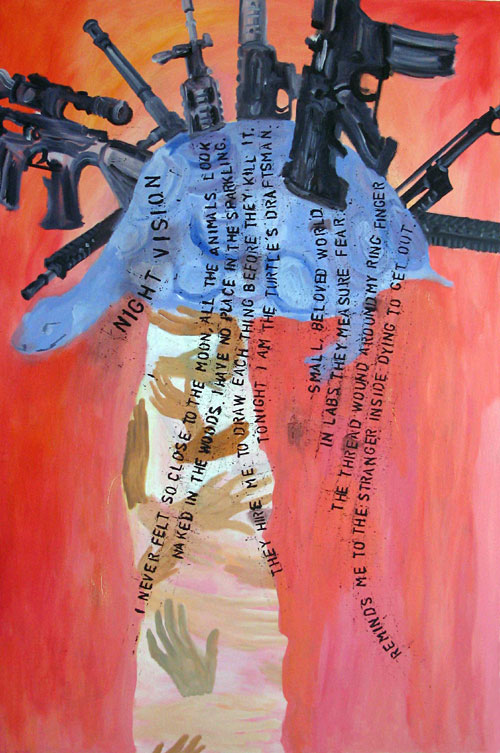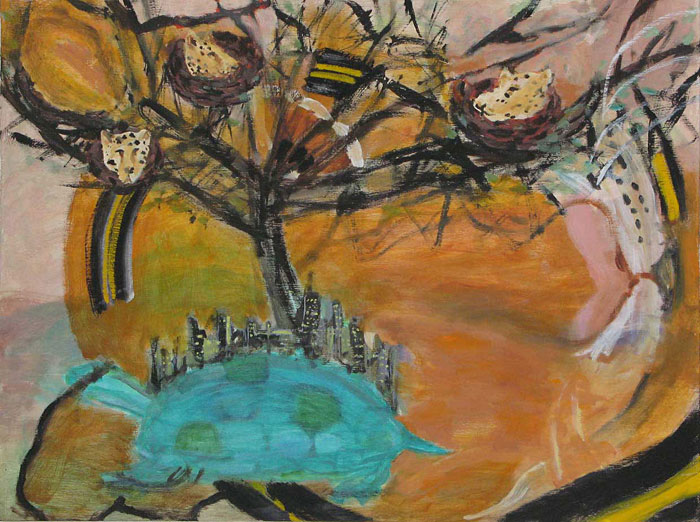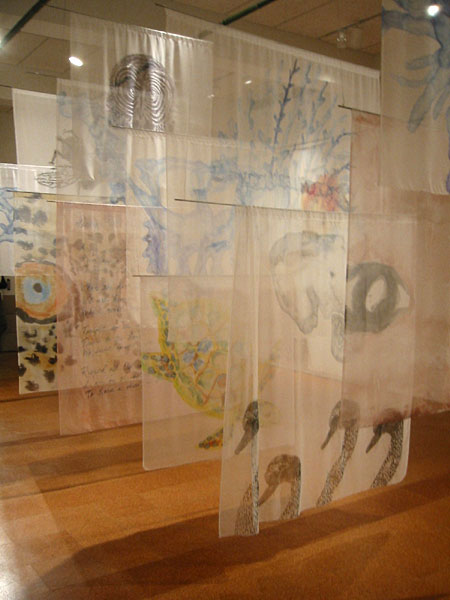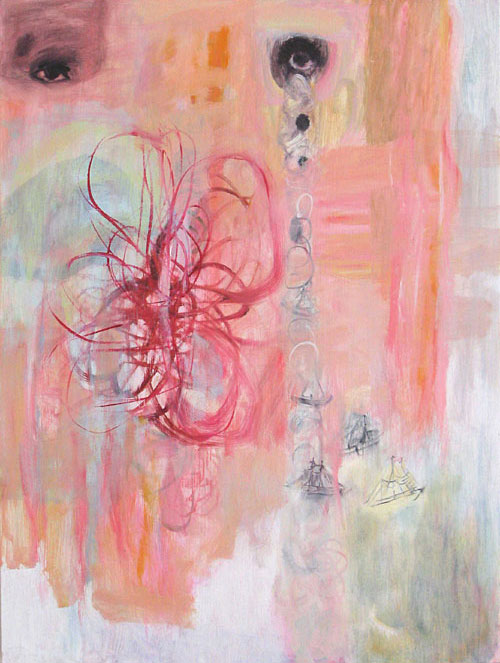Solidly Ethereal
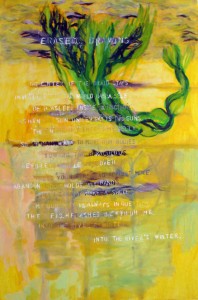 Erased Drawing,2009, oil on canvas, 60″ X 40″
Erased Drawing,2009, oil on canvas, 60″ X 40″All artwork by Desirée Alvarez
The poems, paintings and fabric art of Desirée Alvarez are solid and ethereal at once: solid because all her art reflects the rigor of her literary and visual training, and is grounded in the specific details of the world; ethereal because the specific details of her poems and paintings are suffused with contradictions and longings, and seem to reach into other realms for all those elusive feelings and qualities and constructs that we can never pin down or fully grasp: loss, truth, love, self, what it means to be human.
Alvarez paints “to give face to that which is hidden.” Her art – whether in words or images, whether about what is hidden or revealed – centers on transformation and metamorphosis, or as she describes “the vibrations between creatures and their surround, and the structure of desire.”
Alvarez, 46, has long been a trans-genre artist. She received a BA in fine art and English literature from Wesleyan University, and an MFA from the School of Visual Arts. She writes poetry and non-fiction, and currently teaches in the art department at New York College of Technology, CUNY.Alvarez, who has exhibited her work nationally and internationally, is part of an international drawing collaborative, Weather Report. Her numerous awards, for the visual arts and writing, include an Urban Artist Initiative 2006 grant and the Cork 2005 European Capital of Culture Award.
Her practice involves often working in different mediums in the same day. It is not unusual for her to begin by writing poems in the morning, followed by fabric art in the afternoon and painting at night. In many ways, her large printed fabric installations are a bridge between images created by words and by brush strokes. These installations often incorporate words and poems, which in turn create alternative spatial dimensions for both, whether literally above the viewer’s head as inIf The War Goes Very Well,, a poem from the fabric installation pieceBook of Spells, or fabrics suspended vertically which evoke the presentation of ancient tapestries.
Because the fabrics are delicate and translucent, the words and images float in the air in a ghostly way. In this sense they illuminate and resonate with the New Oxford American Dictionary definition of ethereal: “extremely delicate and light in a way that seems too perfect for this world.”
One example of Alvarez’s mixing of written and visual art is Erased Drawing. The poem is included but partially erased on a 60″ X 40″ canvas painted in 2009. The vibrant colors of a green and purple water plant are a stark contrast to the mood of a poem filled with loss. Alvarez paints aliveness; in color and composition the painting appears in full growing season, bathed in glowing yellow light. Yet this painted aliveness includes “extinction” in the words of the poem, in contrast to a hearty green braid of a water plant intertwined within the title and the poem, both the words readable and erased.
Erasure is a rich way to explore the tension between the hidden and revealed. The partial erasure of the poem in the painting is clear, is indeed only a shadow of its full text form. The text of the painting was painted once, then obliterated,then painted again, according to Alvarez.Much will be hidden. In the painting, “invisible,”white on a yellow background,is literally almost invisible. The very title becomes a meditation on art making since the process of working and reworking is integral to the final object, be it poem or painting. Each brush stroke, each word change alters what existed before, with erasure and addition.
The poem, lyric in the 14 lines of a sonnet, begins with a heart-flower image prevalent in Alvarez’s work. The title evokes what is not seen, as do the first two lines: “The center of the braid stays/ invisible. The world has a self” which begs the question of what is possibly the world’s self if we can’t even reliably know our own selves. We intuit Alvarez is also talking about every individual and the possibilities of a vital inner life. “A self/deep asleep inside extinction” is a loss but also tamer ( a word that appears often in her poems) than extinction. Alvarez embeds a recurring theme in her work: “My humanity is always in question.”
“Ashen sun under cloud” is sun obscured but multiple, “is two suns;” or if thought of as offspring, sons. That reading is amplified by a pregnancy image; “The entire day enters my belly.” This is then followed by a likely sexual and spiritual climax: “So many ways to move our bodies/toward the miraculous.” Renewal and loss are often twinned. “Before you leave, loved,/Press your forehead against mine./Abandon holds my hands,/still I cannot make a shell.”
Something is almost always moving in her transformative art, coming and going, often in wind or water. The poem ends with an important disappearance and return to the natural world: “The fish flashes back from me/ into the river’s winter.”
Erased Drawing
The center of the braid stays
invisible. The world has a self
deep asleep inside extinction.
Ashen sun under cloud is two suns.
The entire day enters my belly.
So many ways to move our bodies
toward the miraculous.
Before you leave, loved,
press your forehead against mine.
Abandon holds my hands,
still I cannot make a shell.
My humanity is always in question.
The fish flashes back from me
into the river’s winter.
At the time of this painting, Alvarez was reading a biography of the contemporary painter she most admires, Willem de Kooning, including the scandal Robert Rauschenberg created when he asked de Kooning for a drawing to erase. Alvarez also feels a kinship withRauschenberg, the best-known contemporary artist to print on silk. To her delight, she was in a group show, exhibiting large fabric installations beside Rauschenberg’s paintings at the American Academy of Arts and Letters. Her Erased Drawing shares the impetusRauschenberg describes in an interview on YouTube (http://www.youtube.com/watch?v=tpCWh3IFtDQ),the need to pay homage to a master and transcend the past simultaneously. In that interview, Rauschenberg explains that he had been frustrated with experiments of erasing his own drawings until he realized the transformation he was looking for required the collision with other art. He was pleased that de Kooning gave him a challenging piece of mixed media to erase and with the result a month later. “It’s poetry,” he said. In that spirit, Alvarez too works with a completed piece of art – her poem – to create a visual work using erasure.
Violence is also a strong presence in Alvarez’s art. Many poems include violent war imagery; however, they are far from gloomy. The full text of If the War Goes Very Well literally floats, hand-printed on white chiffon and suspended from the ceiling, the largest panel in a huge installation.
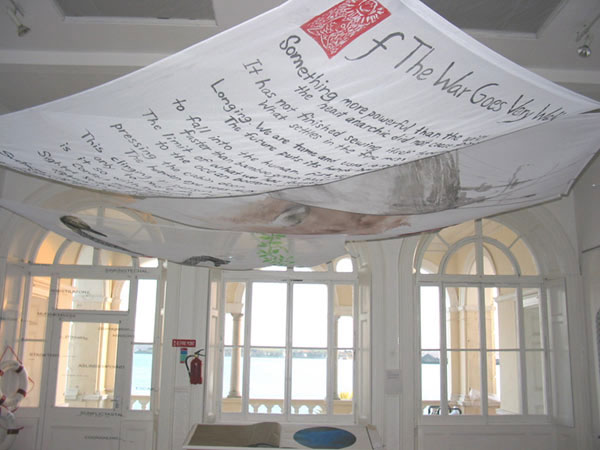
Book of Spells, from installation
9’X 35′(dimensions variable)
silkscreen, ink, woodcut, drypoint and carborundum on chiffon
Book project created for CORK 2005
Exhibited in NYC and Ireland at multiple venues.
If The War Goes Very Well
Something more powerful than the will,
the heart anarchic did not cease firing.
It has not finished sewing itself together.
What settles in the fine mesh:
Longing. We are tame and used to loss.
The future puts its hands into our eyes
to fall into the human. Fast, we grow,
faster than bamboo grows, than a frog bleeds.
The limit of what we had follows us
to the ocean bottom: a fish shadow
pressing the cabin door.
The human eye sees forty shades of grey.
This clinging to person and place
only to move on and under,
is it so with mammals and fish?
Contact sweeps across us every three seconds.
Sighted seaplane through periscope.
Sighted two seaplanes through periscope.
Surfaced. Sighted two planes, submerged.
Sighted the end, submerged.
Out there a great dark thing
will take none of the names we give it.
Book of Spells text, CORK 2005
The poem, in couplets, begins: “Something more powerful than the will,/the heart anarchic did not cease firing.” This uncontrolled heart is not repaired but attempts to find healing, “not finished sewing itself together.”
Throughout the poem, the future thrusts itself in violent ways, “puts its hands into our eyes/ to fall into the human.” We grow. We bleed. We die. “The limit of what we had follows us/to the ocean bottom.” Yet with an artist’s eye, Alvarez reminds us that our limits can themselves be amazing: “The human eye sees forty shades of grey.”
Militaristic images of submarines sighting seaplanes through periscopes precede the ending couplet and heighten the irony of whether any war goes well. “Out there a great dark thing/will take none of the names we give it.” Humans are the only animal to name things but naming does not mean control.
Another piece,Night Vision, at first seems devoid of optimism besides the irresistible sunrise red that bathes the background of the painting, though it’s also the color of faded blood stains. Even the title names a technological advance that improves the killing capacity of soldiers in the dark. In the painting, brown disembodied hands lead the viewer’s eye to the lines of the poem, which because they are vertical instead of horizontal, thrust up with great power into a blue helmet. And from that helmet all kinds of dangerous black guns shoot out. “They hire me to draw each thing before they kill it” radiates as a chilling line, literally from the center of the painting.
Night Vision, 2009, oil on canvas, 60″ X 40″
Night Vision
I never felt so close to the moon, all the animals look
naked in the woods. I have no place in the sparkling.
They hire me to draw each thing before they kill it.
Tonight I am the turtle’s draftsman.
Small, beloved world.
In labs they measure fear.
The thread wound around my ring finger
reminds me to the stranger inside dying to get out.
“Often if I find a solution to a problem in a poem or a painting that informs the other,” Alvarez said in an interview. The composition and surface of the Night Vision painting was troubling until “I started inking the words in letter press and realized I could fit the whole poem which helped me finish the painting.”
A closer look reveals that the “helmet” is a turtle, an animal that recurs in Alvarez’s work to conjure the ancient. “Tonight I am the turtle’s draftsman,” the narrator of the poem explains. Yes, all in the world are vulnerable; “Small, beloved world./In labs they measure fear.” But possibilities of transformation create a kind of resiliency; “The thread wound around my ring finger/reminds me to the stranger inside dying to get out.” Dying and longing become synonyms here. Things will change for better, or worse. Without question, they will change.
Alvarez makes a compelling argument for loving one’s fate, irregardless of the philosophical debates about free will, nature or nurture, even defining what it means to be human. Her poem Amor Fatirefers to the Latin phrase from the meditations of the Roman emperor Marcus Aurelius around 170 AD – to love your destiny, or to accept and be at one with nature. The German philosopher Friedrich Wilhelm Nietzsche (1844 – 1900) also championed the concept of accepting one’s fate, which will inevitably include suffering and loss. One need not accept Nietzsche’s argument to get Alvarez’s philosophical point that being human is at its core a parade of inconsistent and contradictory possibilities.
Amor Fati
Their romance is born within three rings.
Underground, the first ring, is the setting forth.
In his arms her rose scents the room
to press orange against the windows.
In the second, sadder ring, they wear mantles
of mothers and sons, ones left behind,
while all the animals who are their other selves
mark the walls in skins of accident and fear.
The third ring is the limpid world of horizon,
liquid as ships wrought of waves,
birds hatched of water. Pieces of old
dragon ie along the shore for them
to wear as the armor, heavy and mirrored,
in which they were born.
Alvarez poems often contain trinities. The first line, “Their romance is born within three rings,” is romance not defined, nor does it need to be, since human love can extend in many directions. “Underground, the first ring, is the setting forth,” the start of all things human and not human. This is followed by a tender heterosexual reference in the second couplet: “In his arms her rose scents the room/to press orange against windows.” Scent also may be a reminder that sense encompasses all five of our senses. Although Alvarez seldom writes ekphrastic poems, individual lines or images often spring from beloved paintings, such as an orange rose painted by Rene Magritte.
“Alvarez’s poetry is exuberant and visually exciting; her allusions know no geographical boundaries and her lines are woven with color and texture,” Susan Stewart wrote in the May/June 2008 Boston Review, where the poem was a competition finalist.
“In the second, sadder ring, they wear mantles/of mothers and sons, ones left behind;” Alvarez branches out both to the intensity of Mother/Child love as well as the inevitable loss in all love, emphasized by the “ones left behind” which evokes the image of the violence of war where until recent history, women and children, whether male or female, stayed home.
And humans, while animals, are the only ones who likely ponder their future, a gift and a curse. Alvarez correctly emphasizes in the next couplet, that loss and danger are always present; “while all the animals who are their other selves/mark the walls in skins of accident and fear.” She is reminding us too that all humans are animal both in the basest and best sense.
“The third ring is the limpid world of horizon,/ liquid as ships wrought of waves.” Given that if we started in the underground, now we should be arriving in the heavens. Her heavens are limpid, which suggests freedom from anything that darkens, completely clear.
The poem ends with two couplets: “birds hatched of water. Pieces of old/dragon lie along the shore for them/to wear as the armor, heavy and mirrored,/in which they were born.”
Myth offers protection yet also weighs humans down. Armor also invokes amor, the love present in the title.The repetition of “ring” as well as “r” sounds in numerous different words, pull the poem together in sonic as well as visual ways. Another alliteration technique Alvarez uses effectively is combined with clever enjambment: “they wear mantles/of mothers.” In the fifth couplet both within and across lines, the repeated l’s and w’s, work with the assonance of repeated vowel sounds within several closely connected words: “The third ring is the limpid world of horizon,/liquid as ships wrought of waves.”
A title with several incarnations isPeaceable Kingdom, inspired by a small painting by Pablo Picasso. Picasso’s minotaur has tossed a ladder, a framed canvas, a dead horse, a tree, a rainbow, the night sky into a cart he is dragging behind as if on his way to make a painting, or a myth. In Alvarez’s oil painting, a turtle drags the New York skyline and a tree full of nesting cheetahs across a jaguar backdrop.
“Thus began a series of open-ended allegories that nod to [American folk painter] Edward Hicks with visions of harmony between the human and the natural world,” said Alvarez, who titled a 2010 show at the Minor Memorial Library Community Gallery in Roxbury, Conn.Peaceable Kingdom.
About a dozen of her oil paintings lined the walls, and two 20-foot, scroll-paintings on silk chiffon hung from the ceiling of the gallery, just barely touching the floor. Many of the oil paintings seem like allegorical tales, part of a larger myth unscrolling. Also on display were some of her sketches, dry-point etchings and poems.
Painting on silk “is very immediate, with little room for error,” Alvarez said. This method of working increases the pressure of seizing the transformative moment. “You can’t always tell if you’ve got what you want. If you don’t get it the first time, you don’t have it. It makes watercolors seem as easy as paint with numbers.”
Peaceable Kingdom has had other incarnationsas fabric art. A related poem,Design for the Lid of Pandora’s Box,was included handwritten in ink on fabric in an installation inManderino Gallery at California University in 2006, and the title influenced the visual form of its next life. Alvarez hung blue ink paintings on chiffon of extinct creatures with woodcuts and ink paintings of living creatures in an ethereal box in a New York City gallery.
Chaos tumbles out with the open lid in the start of the poem: “Anger was in love/with the world for Delacroix./Never enough violence.” The narrative voice of myth is “on the other side of hope/wanting a child of fur or feathers.” Restoration seems possible when humans can be more integrated in the natural world; “When the dirt is just dirt/we will be human again.”
Design for the Lid of Pandora’s Box
Anger was in love
with the world for Delacroix.
Never enough violence.
Which wild animal stays
in the cage tonight
so the baby can sleep?
Precise to the heart we lived
inside until the lid ripped off.
Out came the sequoias, forsaken.
Precarious little land of plenty.
I am on the other side of hope
wanting a child of fur or feathers.
When the dirt is just dirt
we will be human again.
Although Alvarez lives and works in a loft on Canal Street in Manhattan, the natural world she knows best is the section of Connecticut near Roxbury. Four generations of women in her family have lived in a19th-century tobacco barn in Bridgewater. She still visits her mother there often on weekends and has a summer studio on the grounds.
She grew up hiking in the woods there. “Where I found inspiration and sketched from nature,” she said. “My paintings reflect a seamless relationship between the outdoors and my imagination.”
Evenlocating her work in the natural world, her imagination is always reaching for the mythic. She considers the paintingWhen We Put the Wings On the progeny of the paintings and fabric installations in the Roxbury show as well as the poems Giacomettiand and Amor Fati.
Giacometti
I heard you say you were there
when they put the wings on the angel.
You saw the blood in its eyes,
the stains from the nails streaking the woodcarver’s
door, the ship in full sail, clover and all
the true flowers for it to be May.
Inside me all the time it is snowing.
If myth is the part of the story that bleeds
carry the rope to me gently not as a whip
but as an impossibly slender woman,
alabaster, and filled with perfume.
I no longer believe in the boundless
and the dog watches me
always now, but I still want you
to bury me so I can ride in the old chariot
of wild fig tree with oiled pigskin wheels
out of the kitchen bright into the next form.
The title of the painting references an altarpiece Alvarez saw while visiting a restorer friend at the Metropolitan Museum of Art. She misunderstood his remark about “when we put the wings on” as a reference to the angel’s wings instead of the side panels of the triptych. Narrative references from the Merode Altarpiece also enrich the poem. Joseph is drilling holes in a piece of wood in his carpenter’s workshop in one of the painting’s side wings; Mary is reading quietly at home, adding other layers of meaning to the resonant last line of the poem “out of the kitchen bright into the next form” since the fate of this family will dramatically change as the angel Gabriel is just about to tell the Virgin Mary she will be the mother of Jesus.
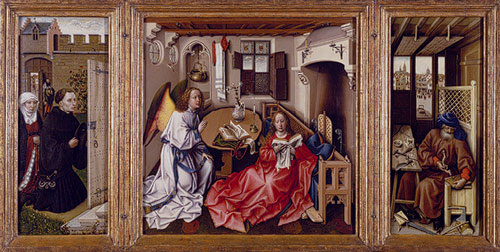
Annunciation Triptych (Merode Altarpiece), ca. 1427 – 1432
Workshop of Robert Campin (South Netherlandish, active by 1406, died 1444)
South Netherlands (modern Belgium), Tournai
Oil paint on oak
Central panel 25 1/4 x 24 7/8 in. (64.1 x 63.2 cm); each wing 25 3/8 x 10 3/4 in. (64.5 x 27.3 cm)
The Cloisters Collection, 1956 (56.70)
The first half of the poem is replete with mythic images. Yet the hinge, in the bottom line of the fourth couplet, “If myth is the part of the story that bleeds,” painfully acknowledges human mortality. The next line invokes an offering: “carry the rope to me gently not as a whip,” which asks for rescue yet raises at the same time potentialviolence in the image of a whip.
“I no longer believe in the boundless” is earth-anchored by the start of the seventh couplet “and the dog watches me.” As do the two eyes in the painting that seem not of the same creature. They look both human and not human and animal and not animal and are set above an abstract heart or wings or “all/the true flowers” of interwoven circles where parts are the deep red of spilled blood. Most of the shimmering colors of the painting are lighter and seem to constantly be blending and separating depending on the time of day and nature of the light. The only constant besides the deep red is black, which begins with the eyes.
Eyes are everywhere in Alvarez’s poems and paintings, another reminder of how she is exploring I as the self. The far right eye bleeds a line of images: first a full black circle, followed by a circle fragment and then several teardrop-like images that become ships, possibly ancient, which start to sail to other places, pointing off the canvas into an unknown realm of transformation and metamorphosis.
Decisions in painting or poem making are intuitive for Alvarez. Although color is a crucial tool for her, she never studied color theory until she needed to learn the science to teach a class. Only then did she realize she mostly uses “hot, fully-saturated colors,” which means she seldom mixes in white or black. There is a similar strength to her diction which tends toward short, Anglo-Saxon words. Yet, in each case the assembly of the various individual parts creates a fluid feeling of mystery and metamorphosis.
During graduate school, Alvarez partially supported herself as a nude model for the painter Philip Pearlstein, an experience that still influences her painting and her poems. While holding a pose for hours, she used the time to make or edit poems and paintings in her head. Normally, “it would be a painting day or a poetry day.” If a painting day, she would move things around mentally to see the changes. Alvarez said her paintings usually begin as a “complete vision” but inevitably need to be revised as she begins to put it down on canvas, wood or fabric. Poetry begins for her sonically, as a line or series of lines. “If it was a poetry day, I would be hearing things I was starting or rewriting.”
Currently in her studio Alvarez is assembling a “tapestry of flight” commissioned by Central Booking, a Brooklyn gallery dedicated to book arts. When finished, the “pages of fabric” will be stitched together and hung horizontally, a book about 25′ by 4′. Completed pages include a very detailed hawk, a single feather, a minimalist bird in flight about the same size of the single feather and a huge angel’s wing from a fresco in the Villa of the Mysteries in Pompeii, Italy. The birds look like feathers and the feathers look like birds. Diving down into this mix is a carborundum print of a fighter jet, the only image not printed as a woodcut. Nearby, the title page of her poetry manuscript The Innermost Animalsits in a not-yet-thrown-out broken printer, as if it’s her mantra to analyze “the vibrations between creatures.”
Birds are another recurring motif in Alvarez’s work. As a child, she spent many weekends sketching in Connecticut from anAudubon book. In a previous and related poem Vanishing Point, the narrator claims “I have lived long in the book of birds.” The music in the simple declarative statement comes from the alliteration and assonance of repeated l’s, b’s and vowel sounds.
Vanishing Point
My job was to dust the ancient sculpture heads.
I held their tiny clay chins in my palm and
brushed their lips with soft sable.
But since then I have lived long in the book of birds,
nests of mud and stick, and there are none that I could build. I do not think I will have a child.
The sailboat moves downriver, briefly puncturing the sky.
Now, painting, the why of movement getting louder
every day, deciding which to keep, which to keep away.
Transformation for humans in our lives and in our art is influenced by chance as much asconscious decisions, Alvarez argues. The mysterious first stanza is a literal description of dusting Perlstein’s eclectic artifacts, as much the subjects of his paintings as the nudes. She then moves to her art and life.She marvels at the intricacy of birds in flight and at rest in “nests of mud and stick, and there are none that I could build.” The following line, the last of the middle stanza, is forceful and reflective of the sorting out that creeps up in middle age: “I do not think I will have a child.”
Then the reader is right back in transformative art as if in the painting When They Put the Wings On as one of the “eyes” or “I’s” or sailing ships. A life, human or animal, like a sailboat “moves downriver, briefly puncturing the sky.” In painting, in life, “the why of movement getting louder/every day, deciding which to keep, which to keep away.”
Whatever happens will shape the future and Alvarez finds lyrical optimism in transformation while frankly acknowledging the attendant and inevitable elements of pain and suffering. She understands the core strengths of the different mediums and uses her versatility to cross-pollinate the different genres. Alvarez paints and prints as a lyrical poet; she writes with the imaginative eye of a visual artist, creating her memorable gossamer creatures.

